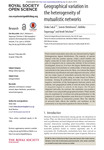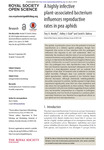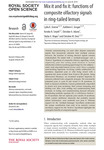Search
Now showing items 1-10 of 17
Discrete but variable structure of animal societies leads to the false perception of a social continuum
(2016)
Animal societies are typically divided into those in which reproduction within a group is monopolized by a single female versus those in which it is shared among multiple females. It remains controversial, however, whether ...
High atmospheric temperatures and ‘ambient incubation’ drive embryonic development and lead to earlier hatching in a passerine bird
(The Royal Society, 2016)
Tropical and subtropical species typically experience relatively high atmospheric temperatures during reproduction, and are subject to climate-related challenges that are largely unexplored, relative to more extensive work ...
Trophic niche divergence among colour morphs that exhibit alternative mating tactics
(2016)
Discrete colour morphs associated with alternative mating tactics are assumed to be ecologically equivalent. Yet suites of behaviours linked with reproduction can also favour habitat segregation and exploitation of different ...
Attack risk for butterflies changes with eyespot number and size
(2016)
Butterfly eyespots are known to function in predator deflection and predator intimidation, but it is still unclear what factors cause eyespots to serve one function over the other. Both functions have been demonstrated in ...
The easternmigratory caribou
(2016)
Understanding the evolutionary history of contemporary animal groups is essential for conservation and management of endangered species like caribou (Rangifer tarandus). In central Canada, the ranges of two caribou subspecies ...
Geographical variation in the heterogeneity of mutualistic networks
(2016)
Plant–animal mutualistic networks are characterized by highly heterogeneous degree distributions. The majority of species interact with few partner species, while a small number are highly connected to form network hubs ...
A highly infective plant-associated bacterium influences reproductive rates in pea aphids
(2016)
Pea aphids, A cyrthosiphon pisum, have the potential to increase reproduction as a defence against pathogens, though how frequently this occurs or how infection with live pathogens influences this response is not well ...
Dopamine regulates termite soldier differentiation through trophallactic behaviours
(2016)
Caste polyphenism in social insects is regulated by social interactions among colony members. Trophallaxis is one of the most frequently observed interactions, but no studies have been conducted identifying the intrinsic ...
Parents face quantity quality trade offs between reproduction and investment in offspring in Iceland
(2016)
How to optimally allocate time, energy and investment in an effort to maximize one’s reproductive success is a fundamental problem faced by all organisms. This effort is complicated when the production of each additional ...
Mix it and fix it
(2016)
Animals communicating via scent often deposit composite signals that incorporate odorants from multiple sources however, the function of mixing chemical signals remains understudied. We tested both a ‘multiple-messages’ ...










